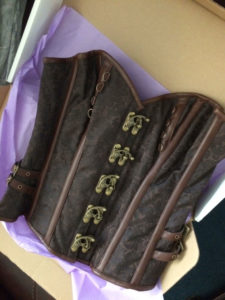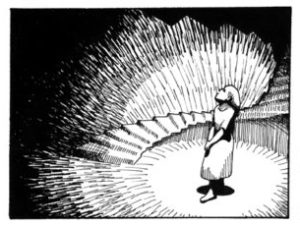Art is scary. A lot of people don’t know what to do with it, so they avoid it. I’ve created art my whole life, and worked in galleries, too, although mostly in charge of the funding. Still, the only formal art appreciation training I had was in a high school art class. I retain only vague recollections of which artists did what, or what their styles are called or influenced by, or which are historically implicated in which revolutions. But the thing is, you don’t need a formal education to look at art. It’s not a rarified skill reserved only for the few. I’ve outlined a few steps for anyone who’s ever felt they couldn’t relate to art because they didn’t know how. We’ll get into the useful parallels for relating to people further on.
Step 1. Find some art. You could go to a museum, or stop by a mural on the outside of a building, or go to the library, or surf somebody’s sketches online, or visit your neighbor’s garage where they’ve converted the back room to a gallery.
Step 2. Shut up. I don’t just mean to stop talking. You need to stop all the noise in your head. It keeps other things from getting in, and it’s not about you, not yet. Shut up and look. Approach the work without expectations or judgement. Hang out with it. If it’s a complex work, leave it for a bit, days even, and come back later to hang out some more.
Step 3. Listen. Some works are dripping with deliberate and obvious symbolism. Some are subtle. Some are literal renderings of everyday things. Some are amorphous colors and shapes. You’ve been waiting patiently, what do you think it is? Do you hear it telling you anything?
Step 4. Respond. (Please wait until this step to do this. So often people respond first, and it will derail the process.) This is not necessarily separate from the previous step. Whatever you heard when you were listening is a big clue to your response. Do you feel something? Irritation? Anger? Amusement? Curiosity? Joy? Kinship? Did you learn something? What do you know now that you didn’t before? That bone structure looks a lot like sponge candy close up? That smears of bright red always remind you of violence, but you think it’s beautiful anyway?
Good job. You’ve just appreciated art.
Why bother?
Well, you might learn something about the artist. The human on the other side of this tenuous, mystical thread of communication might be trying to say something worth hearing. Regardless of whether you know more about the artist, though, you will always know more about yourself. All of that response came from you. Did any of it surprise you?
Also, it may not look like it, but this is skill-building. Being able to observe the signals around you without making yourself the center will help you evaluate situations and resources, make decisions, and yes, communicate with other humans.
What? Looking at art will help me not be an abrasive jerk?
Yes. Follow the steps.
Now let’s say the art is a person. This person is in your space, but they are not like you. You have no idea how to relate. You’ve found the art.
Remember step 2? Shut up. Again, not literally, but do keep oral communication neutral. ‘Hey, I’ve got that report for you.’ ‘It’s supposed to be really hot this weekend.’ ‘Do you want fries with that?’ Whatever expectations or judgement you brought with you to the interaction, the ones clamoring in your head for expression, should be quietly decanted out the back. Again, they will only get in the way of observing the actual person in front of you. (Also, you should never, ever touch this art/person uninvited. The oils from your fingers will indelibly mark the art, and what are you doing anyway? That’s not your art. Were you raised by wolves? If you can’t keep your hands to yourself, don’t be surprised when you’re banned from the gallery.)
Next, listen. But what if you are listening, and the person/art won’t talk to you? The thing is, your understanding of it is ultimately not actually the art’s responsibility. It is doing its thing, living its separate existence. You would look a damn fool standing in front of a painting demanding that it explain itself. Yes. You would. The metaphor stretches a little here, since, obviously, humans can usually talk, but you’re still no more entitled to that person’s time than you are to an explanation from a painting. Even if they took the precious time and effort, if you aren’t ready to listen, you’ve just wasted that much of their energy in a truly ungrateful way.
And if you were really listening, you would have learned something already by now. Things like, ‘That person likes cream in their tea,’ ‘That person is really good at logistics,’ ‘That persons stops smiling and talking every time someone comments on their outfit,’ ‘That person is working three jobs because they’re taking care of their mother and two kids on their own.’ It doesn’t matter if the things you learn directly pertain to your own agenda. They will inform and change you in subtle ways regardless.
It’s hard work, but like any skill, gets easier and more enjoyable with practice. It will change the way you think and open up a whole new dimension of cognitive resources. Not kidding.
So remember, appreciating art, or humans, is not just for people with lots of formal training. You can do it and benefit from it right away. With practice, it will really add to your quality of life. For the sake of easy remembering later, either when faced with a complicated piece of art, or a person you don’t know how to relate to, we’ll boil this down to the two most important steps.
1. Shut up.
2. Listen.
Good luck.



